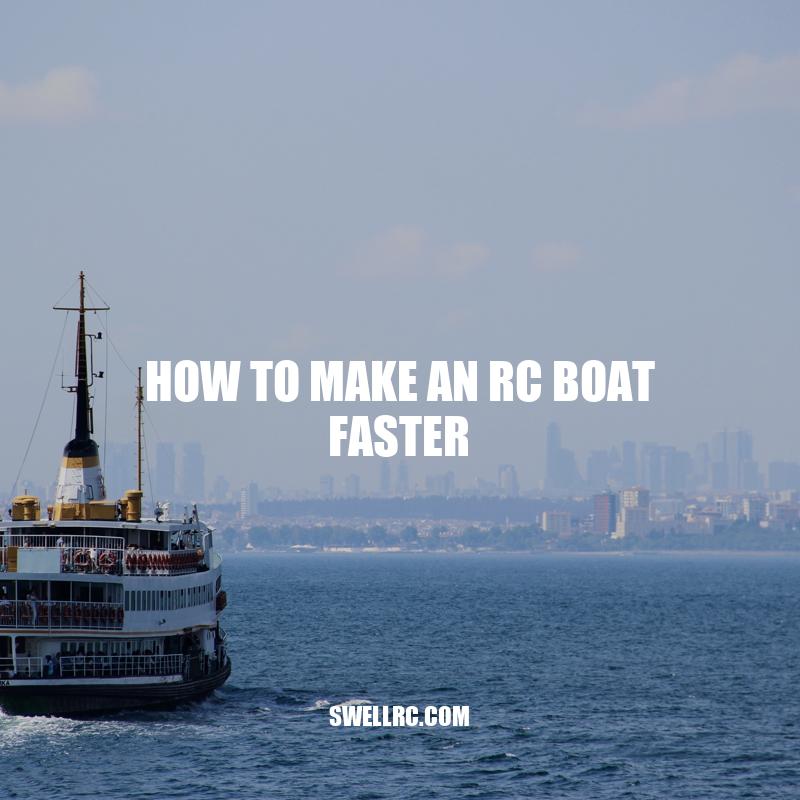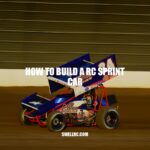Boost Your RC Boat’s Speed with These Expert Tips
Remote control (RC) boats are a popular hobby among those who love the thrill of racing on water. Whether you are a casual hobbyist or a competitive racer, you want your RC boat to reach top speeds and perform at its best. A common challenge that many RC boat enthusiasts face is how to make their boats faster to gain an edge in races. There are several ways to increase the speed of an RC boat, from choosing the right motor to optimizing the propeller design and reducing weight. This article will explore some tips and tricks for making an RC boat faster and performing better, helping you to take your hobby to the next level. By following the guidelines and advice in this article, you can make your RC boat faster and more responsive, giving you the edge you need to win races and impress your fellow enthusiasts.
Choose the Right Motor
To make your RC boat faster, it is essential to choose the right motor. Here are some factors to consider:
Types of Motors:
- Brushed Motors
- Brushless Motors
- Gear Reduction Motors
- Direct-Drive Motors
Considerations for Choosing the Right Motor:
- Boat size and weight
- Battery voltage and capacity
- Desired speed and acceleration
- Budget
Upgrading Your Motor:
If your boat is not reaching top speeds, upgrading your motor might be necessary. Some popular motor upgrades include:
- High-performance brushless motors
- Custom-wound motors
- Custom-built motors
Websites such as RC Boat Parts and Amazon offer a wide range of motors and motor parts for upgrading and optimizing your RC boat.
What are the factors to consider when selecting motors?
When selecting motors, consider the following factors:
- Power requirements
- Speed range
- Physical size and weight of the motor
- Noise level
- Cooling requirements
- Reliability and durability
It’s important to match the motor to the application to ensure optimum performance and efficiency. For more information, refer to the product specifications or the manufacturer’s website.
Optimize Propeller Design
The propeller is an essential aspect of an RC boat that greatly impacts its speed. Here are some tips on optimizing propeller design:
Propeller Materials and Construction:
- Plastic: economical, affordable for beginners but less durable and less efficient
- Aluminum: durable, more efficient, but more expensive than plastic
- Carbon Fiber: lightweight, durable, and more efficient than other materials. However, it is the most expensive option.
Propeller Diameter and Pitch:
| Propeller Diameter | Propeller Pitch | Effect on Speed |
|---|---|---|
| Large Diameter | Low Pitch | Higher acceleration, lower speed |
| Small Diameter | High Pitch | Lower acceleration, higher speed |
Choosing the Perfect Propeller:
To choose the perfect propeller, consider the following factors:
- Boat size and weight
- Motor size and power
- Desired speed and acceleration
- Water conditions (still water, choppy water or waves)
Websites such as Prop Shop Hobbies and RC N Go have a variety of propellers available, and offer guidance and support on choosing the right propeller for your RC boat.
How do I know what size RC propeller I need?
Determining the right size RC propeller depends on several factors such as the size and weight of the RC aircraft, the motor power, and the desired speed. Here are some tips to help you choose the appropriate propeller size:
- Refer to the instruction manual of your RC aircraft for a recommended propeller size.
- Check the motor specifications to find the recommended propeller size.
- Consider the aircraft’s weight and wing area to determine the appropriate propeller size for maximum lift.
- For speed optimization, go for a propeller with a smaller diameter and higher pitch.
- Test different propeller sizes to see which one works best for your aircraft and preferred flying style.
You can also visit websites like HobbyKing or Amazon to find a wide range of RC propellers that vary in sizes and specifications.
Reduce Weight
Reducing the weight of your RC boat can make it faster and more efficient. Here are some tips for reducing weight:
Materials:
- Carbon fiber: lightweight and strong
- Balsa wood: lightweight and easy to shape
- Foam: lightweight and buoyant
- Avoid lead and other heavy metals.
Remove extra weight:
- Add fewer batteries if possible
- Remove ballast if not required
- Use lightweight servos and receiver
- Replace steel screws with alloy screws
Balance weight reduction and safety:
Remember, safety should always come first. Removing too much weight from your boat can make it unsafe and unstable. Ensure you balance safety with weight reduction.
Products:
Items such as carbon fiber sheets, lightweight batteries, and alloy screws can be found on websites like Amazon, Hobbyking and Banggood. You can also find lighter and efficient hardware like carbon fiber propellers, which can make a big difference in speed.
How to lose 4 kg in a month?
Losing 4 kg in a month might seem like a challenging task, but it is achievable with the right approach. Here are some tips to help you reach your weight loss goal:
- Focus on eating nutrient-dense foods that keep you feeling full longer, such as lean proteins, vegetables, and whole grains.
- Avoid processed foods and sugary drinks as they are high in calories and low in nutrients.
- Stay active by incorporating regular exercise into your routine for at least 30 minutes a day, such as brisk walking, cycling, or swimming.
- Drink plenty of water to stay hydrated and avoid sugary drinks.
- Get enough sleep as studies show that lack of sleep can affect weight loss efforts.
Remember to consult with a healthcare professional before starting any weight loss plan to ensure it is safe and suitable for you. For personalized guidance, consider seeking advice from a registered dietitian or personal trainer.
For more information and resources on healthy weight loss, check out trusted websites such as the National Institute of Diabetes and Digestive and Kidney Diseases or the American Council on Exercise.
Fine-Tune Your Boat’s Design
In addition to improving the motor and reducing weight, fine-tuning your RC boat’s design can also contribute to a faster and more efficient boat. Here are some design features to consider:
Hull design:
- Deep V hull: faster and more stable
- Hydroplane hull: less drag, faster speeds
- Catamaran hull: faster and more stable
Trim tabs:
- Adjustable trim tabs to fine-tune handling and improve speed
- Trim tabs can increase stability and help the boat plane faster
Aerodynamics:
- Clean lines and a streamlined shape reduce drag
- A smaller superstructure cuts down on weight and wind resistance
- A flat bottom or shallow-V hull can improve lift and reduce drag
Products:
Specialty websites that sell boats and RC products like RC Planet and Tower Hobbies have a selection of RC boats designed for speed. You can also find design enhancements like adjustable trim tabs and hydrodynamic hulls on these websites. Additionally, websites like RC Groups have numerous tutorials and discussions on boat design and modifications that can help make your DIY design faster and more efficient.
What makes boats faster?
There are several factors that contribute to a boat’s speed:
- The shape of the hull – a streamlined hull with a pointed bow and tapering stern creates less drag, allowing the boat to move faster.
- The weight of the boat – a lighter boat requires less power to move and can therefore go faster.
- The power of the engine – more powerful engines can propel the boat at higher speeds.
- The design of the propeller – a well-designed propeller can increase propulsion efficiency and speed.
- The skill of the driver – experienced drivers can optimize the speed of the boat through efficient use of the throttle and steering.
If you’re interested in improving your boat’s speed, consider investing in a high-quality propeller or upgrading your engine. Visit websites like BoatUS or Boating World for more information on boat performance and products.
Practice Good Maintenance
To keep your RC boat performing at peak speed and efficiency, regular maintenance is key. Here are some tips to keep in mind:
Cleaning:
- Clean hull and propeller regularly to remove debris and buildup
- Use mild soap and a soft brush to avoid scratches on the hull
- Dry the boat well after each use, to prevent corrosion and rust
Lubrication:
- Keep motor and propeller lubricated for maximum efficiency
- Check the motor’s bearings and bushings for wear and tear
- Use high-quality marine grease or lubricant for best results
Testing:
- Test your boat regularly for speed and acceleration
- Keep records of these tests, to identify any changes in performance over time
- Look for any signs of wear or damage that may be impacting performance
Products:
Specialty websites like HobbyKing offer a variety of maintenance products that can help keep your RC boat in top condition. These include lubricants, cleaners, and propeller shaft oilers. Replacement parts, such as motors and propellers, are also available in case of wear or damage. Additionally, many RC boat clubs offer maintenance and repair workshops, where you can learn how to maintain and repair your boat alongside other enthusiasts.
What Maintenance Does a Boat Need?
Boats require regular maintenance to keep them in good condition, ensure safety, and preserve their longevity. Here are some key tasks to keep in mind:
- Clean the hull, deck, and topsides regularly to prevent the build-up of dirt, grime, and saltwater stains.
- Check the engine oil level, coolant level, and fuel filters on a routine basis to prevent any engine problems.
- Inspect the propeller, steering system, and electrical components to ensure proper functioning.
- Replace old batteries, worn-out ropes, and frayed wires for optimal performance and safety.
- Store your boat away from the elements during off-seasons, such as winter or hurricane season, to protect it from harsh weather conditions.
For those looking for more in-depth advice on boat maintenance, companies such as West Marine (www.westmarine.com) offer a wide range of resources and products to help keep your boat in tip-top shape.
Conclusion
In summary, there are several ways to make an RC boat faster. By selecting the right motor, optimizing the propeller design, reducing weight, fine-tuning the boat’s design, and practicing good maintenance, you can improve the speed and performance of your boat. It’s important to remember that safety should always come first, and any modifications or changes should be made with caution and careful consideration. When done correctly, however, improving your RC boat’s speed can make racing and boating more fun and engaging. By taking advantage of the resources available online or through community groups, you can maximize your boat’s potential and become a competitive and skilled RC boat racer.



